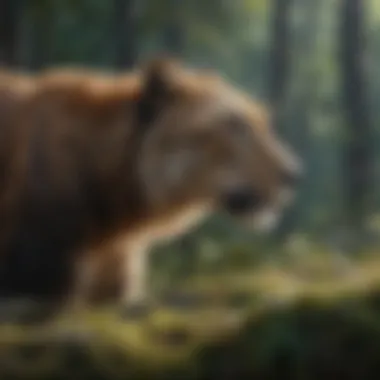Exploring the Impact of Conservation Alliance Grants


Intro
Conservation efforts are crucial in addressing the pressing environmental challenges we face today. As biodiversity declines due to human activities and climate change, various organizations have turned to funding mechanisms, like conservation alliance grants, to support sustainable practices. These grants aim to provide the necessary resources for initiatives that protect ecosystems and enhance biodiversity.
Key Natural Resource Issues
Natural resources are the foundation of life on Earth, providing the materials and ecosystems services critical for survival. However, deforestation, habitat loss, and pollution threaten these resources, leading to extensive biodiversity loss.
Biodiversity includes ecosystems, species, and genetic diversity. Its loss reduces resilience against climate change and disrupts ecological balance. The urgency to replenish these resources is clear. Conservation alliance grants play a significant role in this landscape, connecting funding with intended outcomes.
Background Significance
Understanding the significance of conservation alliance grants is rooted in the need for sustainable management of genuine nature resources. Grants provide financial backing for projects that focus on preserving habitats, safeguarding endangered species, and promoting sustainable land use practices. These initiatives not only benefit the environment but also empower local communities, often relying on these ecosystems for their livelihoods.
The amount and efficiency of such funding can determine the success or failure of conservation efforts. Therefore, exploring the frameworks of these grants is critical as it helps inform stakeholders about effective funding strategies that lead to lasting impacts.
Understanding Conservation Alliance Grants
Conservation Alliance Grants play a critical role in funding initiatives aimed at preserving biodiversity and promoting sustainable resource management. Understanding these grants helps stakeholders recognize the mechanisms that support effective conservation strategies. These grants not only provide financial backing but also often facilitate collaboration among various organizations, enhancing the overall impact of conservation efforts. When organizations apply for these grants, they tap into resources that can significantly leverage their projects, bringing about meaningful change in local ecosystems and communities.
Definition and Purpose
Conservation Alliance Grants are monetary awards given to organizations engaged in conservation activities. Their primary purpose is to support projects that aim to protect natural resources, restore habitats, and enhance biodiversity. These grants serve as a vital funding avenue for non-profits, governmental bodies, and research institutions, allowing them to implement critical conservation initiatives. The objective goes beyond mere financial support; it fosters a community approach in tackling environmental challenges by encouraging collaborative efforts.
Types of Grants Available
Grants come in various forms to address the distinct needs of conservation projects. Each type serves a unique purpose and offers different advantages, ensuring that many aspects of conservation can be funded effectively.
Project Grants
Project Grants are designed to fund specific initiatives that have well-defined goals and measurable outcomes. They contribute significantly to tangible conservation results, making them a preferred option for many applicants. A key characteristic of Project Grants is their focus on short-term objectives, which often leads to immediate benefits for ecosystems and communities.
The unique feature of these grants lies in their ability to provide substantial funding for targeted projects without necessitating long-term commitments. However, one disadvantage may include intense competition, as many organizations seek limited resources within specific funding cycles.
Fellowship Grants
Fellowship Grants support individual researchers or practitioners, offering them the financial means to focus on their environmental studies or community projects. The major benefit is the opportunity given to talented individuals to advance their knowledge and contribute to conservation efforts.
Fellowship Grants often provide a unique feature, such as mentorship opportunities from established conservation leaders. This access to expertise can greatly enhance the effectiveness of the funded projects. On the downside, these grants may not cater to broader organizational needs, which can limit the scale of impact.
Capacity Building Grants
Capacity Building Grants aim to strengthen an organization's ability to implement effective conservation practices. This type of grant often supports training programs, resource development, and institutional improvements. The primary advantage of Capacity Building Grants is fostering long-term sustainability in conservation practices.
One key characteristic is the focus on expanding an organization’s capabilities to manage resources better, ensuring that projects can not only start successfully but also continue to thrive. A potential disadvantage might be that they require a more extended commitment and often take time to show measurable results.
Key Stakeholders in Conservation Grants
In the realm of conservation, engaging various stakeholders is crucial for ensuring the success and effectiveness of grants. Key stakeholders often provide necessary resources, knowledge, and support that can significantly enhance the impact of conservation efforts. Stakeholders include non-governmental organizations, government agencies, and private sector entities. Understanding their roles, strengths, and contributions allows for better collaboration and optimized outcomes for conservation initiatives.
Non-Governmental Organizations
Non-governmental organizations (NGOs) play an essential role in conservation grants. They often act as intermediaries, connecting communities and funding sources. NGOs can mobilize volunteers, create public awareness, and offer expertise in project design and implementation. They are particularly effective at engaging local stakeholders, ensuring that conservation strategies are culturally sensitive and tailored to the needs of specific communities.
Also, NGOs frequently undertake monitoring and evaluation of projects funded through grants. They collect data and assess the effectiveness of conservation efforts, which informs both donors and other stakeholders about best practices in the field. Therefore, their participation enhances transparency and accountability in the use of funds.
Government Agencies
Government agencies have a pivotal position within the conservation financing ecosystem. They provide regulatory frameworks and policy guidance that can enhance the effectiveness of conservation grants. By aligning grants with national and local conservation priorities, agencies ensure that funding is directed to projects that meet pressing environmental needs.


Moreover, government involvement can facilitate access to additional resources. For instance, matching funds or in-kind support can be offered to projects that align with governmental objectives. This partnership not only maximizes the impact of grants but also demonstrates a commitment to sustainable practices at a policy level.
Private Sector and Corporate Contributions
The private sector is increasingly recognized as a vital partner in conservation funding. Corporations may provide direct financial support, or they might engage through Corporate Social Responsibility (CSR) initiatives aimed at enhancing their environmental impact. These contributions can help fund innovative projects that address complex environmental challenges.
Furthermore, corporate entities bring expertise in project management, technology, and scalability. This technical approach can lead to the development of more robust projects that may otherwise lack resources. Collaborating with the private sector allows conservation organizations to leverage additional knowledge and networks, creating a more comprehensive approach to environmental challenges.
The Application Process
The application process for Conservation Alliance Grants is crucial. It not only determines who can access funding but also shapes how effectively those grants are utilized. Understanding this process is vital for stakeholders, ensuring that applicants are well-prepared to meet the demands of grant providers. The process typically includes several key steps, from confirming eligibility to submitting proposals and undergoing evaluation.
Eligibility Criteria
Eligibility criteria serve as the first filter within the application process. They define who has the right to apply for grants. Often, these criteria include aspects like organizational type, project goals, and geographic focus.
- Organizational Type: Non-profit organizations and government entities usually qualify. The criteria may not accept for-profit businesses.
- Project Goals: Projects should align with conservation aims, like biodiversity protection or sustainable resource management. Clear goals help in determining the relevance of the project.
- Geographic Focus: Some grants are region-specific, meaning that only projects in certain areas can qualify. This is often based on conservation needs or priorities.
Understanding these criteria early can save time and resources for applicants, allowing them to focus on suitable grants.
Writing a Successful Proposal
Proposals must outline project objectives, methods, and anticipated outcomes. A well-structured proposal often includes several essential components that can strongly influence success.
Essential Components
The essential components of a proposal can significantly contribute to its success. Generally, proposals include:
- Executive Summary: A brief overview of the project.
- Project Description: Detailed information of objectives and methods.
- Budget: A clear financial plan.
These components play a crucial role in conveying the project's importance to reviewers. A clear executive summary captures attention, while a solid project description describes the impact. Budget clarity ensures that funding needs are transparent, enhancing the proposal’s credibility.
Common Pitfalls
Common pitfalls often derail even the strongest applications. Some typical mistakes include:
- Vagueness in Objectives: Unclear goals can lead to confusion.
- Ignoring Guidelines: Not adhering to specific requirements set by the granting organization can result in rejection.
Understanding these pitfalls is critical. Vagueness in objectives may leave reviewers uncertain about the intended impact, while ignoring guidelines can be seen as a lack of seriousness regarding the application. Avoiding these errors is essential for crafting a successful proposal.
Review and Selection Process
Once proposals are submitted, they enter the review and selection process. This phase determines which projects will receive funding.
Evaluation Criteria
Evaluation criteria guide reviewers in scoring applications. These criteria commonly focus on:
- Project Relevance: Alignment with conservation goals.
- Feasibility: Ability to implement the project successfully.
- Impact: Expected outcomes on conservation efforts.
These criteria help in making objective assessments of proposals. By focusing on project relevance, feasibility, and impact, grant review committees can prioritize funding projects that are most likely to succeed.
Scoring Systems
Different scoring systems may be employed in the evaluation process. These systems typically rank proposals based on the established criteria. Key characteristics of scoring systems include:
- Weighted Criteria: Assigning different importance to aspects like impact versus feasibility.
- Numerical Scoring: Allowing for a quantitative comparison of proposals.
A scoring system can bring clarity to decision-making. By using a weighted approach, the reviewers can prioritize areas that align more closely with conservation goals. It helps to make the selection process more consistent and transparent.


Clearly understanding the application process can greatly enhance an applicant's chances for success. Each component plays a significant role in overall effectiveness.
Impact of Conservation Alliance Grants
The impact of Conservation Alliance Grants is a critical element within the broader context of environmental conservation efforts. These grants directly influence biodiversity preservation and resource management, providing essential funding for projects that aim to restore ecosystems and promote sustainable practices. The grants empower organizations and individuals, fostering innovative solutions to pressing environmental issues.
By understanding the ways these grants affect both local communities and global ecosystems, stakeholders can make informed decisions that enhance the overall efficacy of conservation initiatives. The grants not only fund projects but also facilitate knowledge sharing, capacity building, and network opportunities among conservationists. This creates a ripple effect, amplifying the positive outcomes these projects can achieve.
Case Studies of Successful Projects
Biodiversity Restoration
Biodiversity restoration projects have become a popular choice for grant funding, primarily due to their direct contribution to enhancing ecological health. These projects often focus on restoring native habitats, reintroducing species, and removing invasive species. A key characteristic of biodiversity restoration is its ability to revive ecosystems and improve resilience against climate change.
The unique feature of such projects lies in their holistic approach. They do not merely address one aspect of an ecosystem; instead, they seek to restore entire ecosystems, benefiting various species and communities. However, challenges can arise, such as the potentially high cost of restoration efforts, which might lead to funding shortfalls.
Community Engagement Programs
Community Engagement Programs play a significant role as well. They strive to involve local populations in conservation efforts, creating a sense of ownership and responsibility. One key aspect is the emphasis on education and outreach to raise awareness about environmental issues. These programs encourage community members to actively participate in conservation initiatives, fostering a culture of stewardship.
The unique feature of community engagement programs is their focus on collaboration. They unite diverse groups, enhancing social cohesion while promoting environmental awareness. However, the challenge remains in ensuring sustained participation from the community over time, which can make these programs difficult to maintain.
Challenges Faced in Implementation
Funding Shortfalls
Funding shortfalls are a common challenge faced by many conservation initiatives. Often, the funding provided through grants may not cover the full scope of a project, leading to delays or halts in progress. This is particularly pronounced in long-term conservation efforts that require consistent financial support. A notable characteristic of funding shortfalls is that they can limit the scale and scope of potential projects.
The unique feature of these shortfalls is that they force organizations to rethink their strategies. Often, additional fundraising efforts must be initiated, which can detract from the core mission of the conservation project. This situation can lead to decreased morale among staff and volunteers.
Monitoring and Evaluation Issues
Monitoring and Evaluation Issues represent another hurdle in the conservation landscape. Effective monitoring is crucial for assessing the impact of funded projects and ensuring accountability. A primary characteristic of this issue is the variability in methods used for assessment, leading to data inconsistencies.
The unique feature of this challenge is that it can compromise the integrity of project outcomes. Without reliable data, it becomes difficult to gauge success and make necessary adjustments. This can create a cycle where funding is misallocated because the proven results may not be immediately visible. Streamlined monitoring processes are essential for improving transparency and effectiveness in conservation initiatives.
Best Practices for Grant Management
Effective grant management is essential to the success of any conservation initiative. Grants represent a significant investment of resources aimed at preserving biodiversity and supporting resource management. By implementing best practices in grant management, organizations can ensure that these resources are used efficiently and yield maximum benefit. This section outlines key strategies that can enhance the management of conservation alliance grants. It emphasizes the importance of collaboration, sustainability, and efficient resource allocation in achieving long-term project success.
Building Partnerships
Collaborative Approaches
Collaborative approaches in grant management involve multiple stakeholders working together to achieve common goals. This strategy is vital for amplifying the impact of conservation initiatives. A key characteristic of collaborative approaches is the pooling of resources, knowledge, and expertise among partners. This not only enhances project capacity but also fosters innovation.
One unique feature of collaborative approaches is their ability to forge strong relationships between organizations and communities. By engaging local stakeholders, projects can benefit from on-the-ground knowledge, which is invaluable for tailoring initiatives to specific needs. However, these collaborations can also present challenges. Potential disadvantages may include differing priorities among partners, which can complicate decision-making processes and affect project timelines.
Networking Strategies
Networking strategies are essential for connecting with other organizations, experts, and funding bodies in the conservation sector. These strategies are vital for sharing information, resources, and experiences that can inform project development and implementation. A defining characteristic of networking strategies is their ability to create a supportive community around conservation efforts, increasing visibility and advocacy for projects.
One unique aspect of networking strategies is their focus on continuous learning and knowledge sharing. This fosters an environment where innovative ideas can flourish. However, the challenge often lies in the maintenance of these networks. Over time, relationships require effort to sustain and can be difficult to manage, particularly across diverse organizations with varying objectives.
Sustainability Planning
Long-term Impact Measurements
Long-term impact measurements are crucial for assessing the effectiveness of conservation projects. By focusing on outcomes beyond the immediate results, organizations can evaluate the sustainability of their efforts. A key characteristic of this practice is the establishment of clear indicators that reflect both ecological and social outcomes. Utilizing these measurements can significantly enhance accountability and transparency in grant management.


A notable feature of long-term impact measurements is their role in informing future projects. By analyzing what works and what does not, organizations can refine strategies and improve the effectiveness of future initiatives. However, the disadvantage is that gathering this data can be resource-intensive, requiring dedicated time and effort that may divert focus from immediate project goals.
Resource Allocation Strategies
Effective resource allocation strategies are fundamental to maximizing the use of funds in conservation projects. This aspect of grant management involves careful planning and prioritization to ensure that all resources are directed appropriately. A key characteristic of these strategies is their focus on aligning available resources with the objectives of the project.
One unique feature of resource allocation strategies is the need for flexibility. Responding to changing project contexts or unexpected challenges ensures that resources are used efficiently. However, the potential downside is that overly flexible strategies may lead to uncertainty, making it difficult to maintain consistent progress toward project goals.
The outcome of implementing best practices in grant management is an increase in the overall success of conservation projects. By building partnerships, focusing on sustainability, and ensuring efficient resource allocation, organizations can significantly enhance their impact in biodiversity conservation.
Future Directions for Conservation Funding
The landscape of conservation funding is continuously evolving. Understanding future directions in this area is essential for ensuring long-term sustainability of environmental projects. This section delves into innovative models and the integration of technology in grant processes. These topics highlight how funding can adapt to meet emerging challenges and opportunities in conservation.
Innovative Funding Models
Crowdfunding
Crowdfunding has emerged as a significant method for financing conservation initiatives. This approach allows individuals to contribute smaller amounts to larger projects. One key characteristic of crowdfunding is its ability to engage a broad audience, making conservation accessible to anyone interested. This democratization of funding can draw in resources that traditional models might overlook.
The unique feature of crowdfunding is its reliance on online platforms to gather contributions. People can easily share, support, or donate to campaigns through social media, creating a community of supporters.
However, there are advantages and disadvantages to consider. On the positive side, crowdfunding fosters genuine engagement and raises awareness for specific projects. On the downside, it can lead to inconsistencies in funding levels. Not every campaign may reach its goal, meaning some projects might not get off the ground as expected.
Impact Investments
Impact investments represent a shift in funding paradigms for conservation. These are investments made with the intention to generate positive social and environmental outcomes alongside a financial return. One of the main characteristics of impact investments is their dual focus on profit and purpose, aligning closely with conservation goals.
The distinctive feature of impact investments is the emphasis on measurable outcomes. Investors often want to see tangible results before committing funds, which aligns with the need for accountability in conservation.
The advantages of this model include access to larger pools of capital and enhanced sustainability for projects. Conversely, the challenges include heightened expectations for measurable impacts, which can create pressure on conservation groups to deliver quick results rather than focusing on long-term benefits.
Integrating Technology in Grant Processes
Digital Applications
Digital applications have revolutionized the way grant proposals are submitted and processed. They streamline the entire application process, making it easier for applicants to submit their proposals digitally. A key characteristic of digital applications is that they can often be completed more efficiently than traditional paper-based submissions.
One unique aspect of digital applications is the ability to include multimedia elements. For example, video presentations can enhance proposals and give a clearer picture of project plans. This can be particularly beneficial in capturing the attention of grant reviewers.
However, there are potential downsides, including technical barriers for some organizations. Not all applicants may have easy access to technology or the internet, which can limit participation in grant opportunities.
Data Analysis for Impact Assessment
Data analysis has become an indispensable tool for assessing the effectiveness of conservation projects. By applying data analysis techniques, organizations can evaluate their impacts rigorously. A primary characteristic of this approach is the emphasis on evidence-based decision-making.
The unique feature of data analysis for impact assessment is its ability to provide clear metrics and insights. This is critical for reporting to stakeholders and securing future funding.
Nonetheless, the challenges include the need for specialized skills and tools for proper analysis, which may not be available to all conservation programs. There is also the risk of over-reliance on quantitative data, potentially overlooking qualitative aspects of conservation projects.
End
The conclusion serves as a pivotal component of this article, encapsulating the major themes discussed concerning conservation alliance grants. Understanding these grants is vital for various stakeholders involved in conservation work. The synthesis of information reiterates the significance of informed funding mechanisms, strategic planning, and collaborative efforts. Through effective utilization of conservation grants, many communities have achieved substantial milestones in biodiversity protection and resource management.
Summary of Key Points
In this article, several critical elements were explored:
- Definition and Purpose: Conservation alliance grants are designed to support projects that aim to preserve ecosystems and enhance sustainability.
- Types of Grants Available: Different grants, including project grants, fellowship grants, and capacity building grants, cater to specific conservation needs.
- Key Stakeholders: Non-governmental organizations, government agencies, and private sectors play a significant role in financing and supporting conservation efforts.
- Application Process: Clear eligibility criteria and proposal writing strategies were outlined to assist applicants.
- Impact Assessment: Emphasis was put on successful projects alongside challenges faced in implementation, including funding shortfalls.
- Best Management Practices: Strategies for building partnerships and planning for sustainability were discussed.
- Future Directions: Innovative funding models and technology integration are critical for enhancing conservation initiatives.
Calls to Action for Stakeholders
This article emphasizes a call to action for all stakeholders involved in conservation efforts:
- For Grant Seekers: Understand thorough eligibility requirements and align projects with the objectives of conservation funds. Writing compelling proposals can significantly enhance your chances of securing funding.
- For Funders: Consider investing in partnerships that prioritize long-term impacts and sustainability. Engaging in innovative funding models can diversify risk and maximize positive outcomes.
- For Community Groups: Foster collaboration with NGOs and private sectors to leverage resources. Sharing knowledge is crucial for formulating comprehensive conservation strategies.
- For Policymakers: Advocate for policies that support transparency in grant processes. Encourage investments in conservation funding as an integral part of environmental legislation.
Engagement from all parties involved is necessary to ensure the successful application of conservation alliance grants, ultimately leading to better management of natural resources and enhanced biodiversity.



